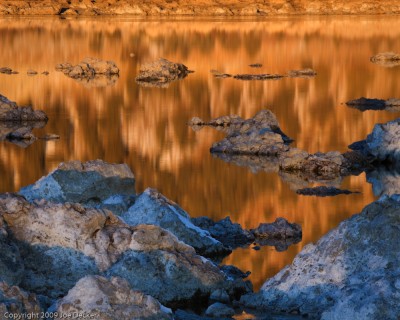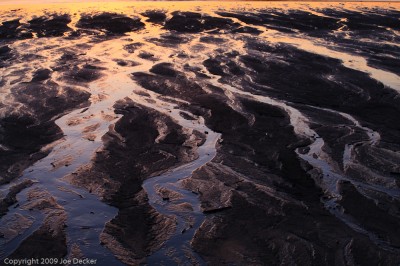
The power and beauty of an exceptional sunrise or sunset is incredible. As nature photographers, it is understandable that we gravitate towards the most direct expressions of these incredible moments. Those sunrises and sunsets often offer not only incredible color in the skies, but also on the landscape itself–color that shows texture and contrast by raking across our subjects. Trying to pull in the whole picture, capturing all of this, is a wonderful goal.
Sadly, all too often, the skies don’t light up the way we expect. Or other factors get in the way of these hopes. In remaining attached to our vision of the grand scene, it is all too easy to give up and to forget what powerful alternatives can remain. Often, I find those alternatives include reflections.
This first image from Mono Lake is typical. The Old Marina area sits at the west end of the lake near the base of the Sierra Nevada. The land is more open to the east, leaving open excellent (but oft-unfulfilled) promises for blazing sunrises. This particular morning the air was clear but no clouds were around to help create that grand scene. So, I started thinking about capturing the warm light that would soon wash across the Sierra Nevada, but that left me photographing across Highway 395, which separates the lake from the mountains. By focusing on reflections in the lake I was able to find compositions that omitted the unsightly highway but captured the warm orange sunrise glow.

A nearly cloudless sunset near the end of my Oregon Coast photo workshop last year provides another example. That evening, a lack of clouds to the west left the sunset sky orange but without detail. While the mouth of Sunset Bay provided some reasonable opportunities for silhouettes against the plain orange background, the lack of detail in the orange failed to truly capture my imagination. I recalled some interesting water patterns along the beach edge I’d noticed earlier in the day, realized that those could provide interesting forms and detail, scampered back to that section of beach and shot the Sunset Bay image here. That image turned out to be one of my favorites from the entire Oregon trip.
Working through these hurdles is simple. Take a deep breath, and accept that the Big Sunset isn’t going to happen, and look for what light, color and interest is available. Focus on what good stuff you have to work with. If you’ve got color but there are no clouds to create texture or form, then your job is to find a composition that introduces texture and form to that color, often (but not necessarily) with water reflections.
If there is great color and texture but it is in a very limited part of the sky, look for compositions that mix a lot of foreground interest with a little bit of that sky. Work to maximize the amount of your image that shows the sweet light and to leave out as much of what’s not working as possible. Water reflections can lend a hand here too, sometimes–in compositions that include both the small area of interest in sunset clouds but that also manage to pick up their reflections.
So, don’t despair, a weak sunset can often make for great photographic opportunities–if you stop, let go of your preconceptions, and begin to see anew.

Bob Towery
15 Jun 2009This is a really good post (nice pics too, of course). As a photographer, you just have to work with what you have. I think what separates the good from the great is the ability to always find a compelling scene, no matter what the circumstances. It’s always there, but we have to work for it.
Jane
15 Jun 2009you have a very nice picture attached to the post! and i like majing images of this kind, though it’s hard to catch the moment